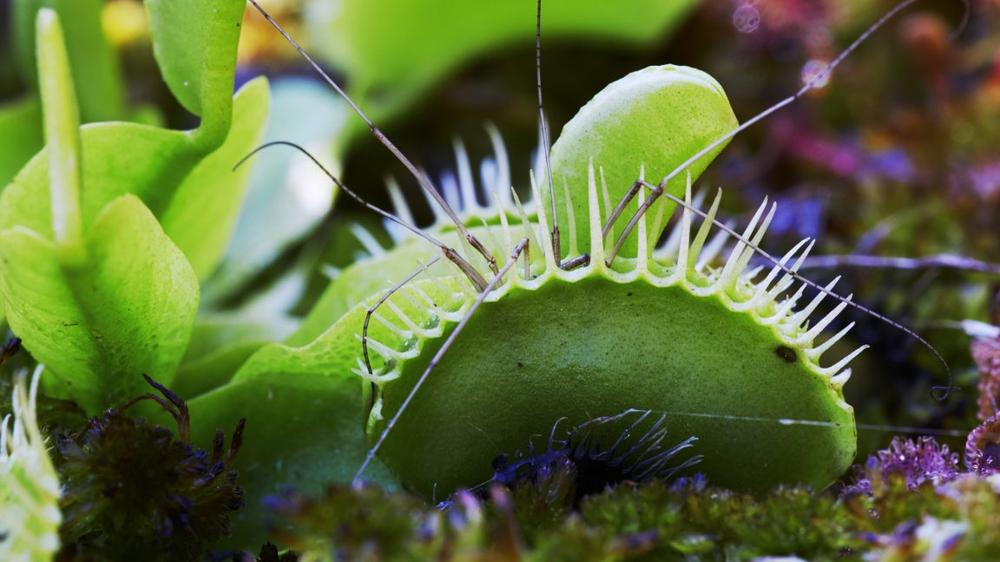To trap its prey, the Venus flytrap sends rapid electrical impulses, which are generated in response to touch or stress. But the molecular identity of the touch sensor has remained unclear. Japanese scientists have identified the molecular mechanism that triggers that response and have published their work in a new paper in the journal Nature Communications.
As previously reported, the Venus flytrap attracts its prey with a pleasing fruity scent. When an insect lands on a leaf, it stimulates the highly sensitive trigger hairs that line the leaf. When the pressure becomes strong enough to bend those hairs, the plant will snap its leaves shut and trap the insect inside. Long cilia grab and hold the insect in place, much like fingers, as the plant begins to secrete digestive juices. The insect is digested slowly over five to 12 days, after which the trap reopens, releasing the dried-out husk of the insect into the wind.
In 2016, Rainer Hedrich, a biophysicist at Julius-Maximilians-Universität Würzburg in Bavaria, Germany, led the team that discovered that the Venus flytrap could actually "count" the number of times something touches its hair-lined leaves—an ability that helps the plant distinguish between the presence of prey and a small nut or stone, or even a dead insect. The plant detects the first "action potential" but doesn't snap shut right away, waiting until a second zap confirms the presence of actual prey, at which point the trap closes. But the Venus flytrap doesn't close all the way and produce digestive enzymes to consume the prey until the hairs are triggered three more times (for a total of five stimuli).
And in 2023, scientists developed a bioelectronic device to better understand the Venus flytrap's complex signaling mechanism by mapping how those signals propagate. They confirmed that the electrical signal starts in the plant's sensory hairs and then spreads radially outward with no clear preferred direction. And sometimes the signals were spontaneous, originating in sensory hairs that had not been stimulated.
Glowing green
This latest research is an outgrowth of a 2020 paper detailing how the Japanese authors genetically altered a Venus flytrap to gain important clues about how the plant's short-term "memory" works. They introduced a gene for a calcium sensor protein called GCaMP6, which glows green whenever it binds to calcium. That green fluorescence allowed the team to visually track the changes in calcium concentrations in response to stimulating the plant's sensitive hairs with a needle. They concluded that the waxing and waning of calcium concentrations in the leaf cells seem to serve as a kind of short-term memory for the Venus flytrap, though precisely how calcium concentrations work with the plant's electrical network remained unclear.
This time, Hiraku Suda and Masatsugu at Saitama University sought to visualize the exact moment that a living plant converts a physical stimulus into a biological signal. They used the same fluorescent calcium sensor protein and were able to record how a gentle bending force on the plant produced a corresponding local rise in calcium concentration along with a small local electrical signal. A larger stimulus, however, acted like a switch being flipped, triggering a large electrical spike and a wave of calcium. Both of those signals then spread from the base of the hair out to the blade of the leaf.
The key to the response seemed to be an ion channel (DmMSL10) at the base of the sensory hairs. To test this, the team genetically modified flytraps to knock out that channel. Those plants only exhibited small local increases in calcium concentrations and electrical signals that never exceeded the threshold and spread to the leaves. This means that the ion channel serves as a kind of amplifier to boost the initial signals beyond the critical threshold so that the flytrap can react.
Finally, Suda and Masatsugu et al. tested both unmodified Venus flytraps and knockout plants in a more natural setting, building a mini-ecosystem in which ants were allowed to walk freely over the plants. The ant movement usually caused the unmodified plants to snap shut, but this response was much less frequent and plants snapped shut fewer times.
The authors concluded that the DmMSL10 ion channel is indeed a key mechanical sensor for the flytrap's sensitive sensory hairs. And since many plants have responses tied to mechanosensing, they suggest that this underlying molecular mechanism could extend to other plants besides the Venus flytrap.
Nature Communications, 2025. DOI: 10.1038/s41467-025-63419-w (About DOIs).

 Ultima Ford Focus ST, fine della produzione: addio alla hot hatch
Ultima Ford Focus ST, fine della produzione: addio alla hot hatch